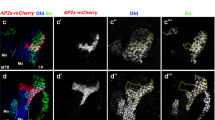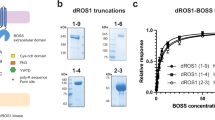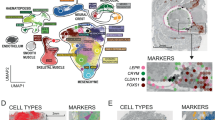Abstract
LIKE other homeobox genes of the Antennapedia and bithorax complexes (collectively called the HOM complex1,2), the Drosophila Deformed (Dfd) gene has structural homologues in the Hox/HOX complexes of mouse and humans, one of which is human HOX4B (refs 3, 4). Previous experiments indicated that HOX4B protein can specifically activate the expression of the endogenous Dfd transcription unit in Drosophila embryos and larvae5. We therefore asked whether HOX4B cis-regulatory elements could mimic the function of a Dfd autoregulatory element6–8 in Drosophila embryos. Here we show that a HOX4B upstream element can surprisingly provide expression in a posterior head segment of Drosophila. One possible mechanism for the axial position-specificity of the human element may involve the conservation of a Dfd-specific autoregulatory circuit in both arthropod and chordate lineages. This possibility is supported by the finding that a Drosophila Dfd autoregulatory element supplies spatially localized expression in the hindbrain of mouse embryos9.
This is a preview of subscription content, access via your institution
Access options
Subscribe to this journal
Receive 51 print issues and online access
$199.00 per year
only $3.90 per issue
Buy this article
- Purchase on SpringerLink
- Instant access to full article PDF
Prices may be subject to local taxes which are calculated during checkout
Similar content being viewed by others
References
Akam, M. Cell 57, 347–349 (1989).
McGinnis, W. & Krumlauf, R. Cell 68, 283–302 (1992).
Mavilio, F. et al. Nature 324, 664–667 (1986).
Regulski, M., McGinnis, N., Chadwick, R. & McGinnis, W. EMBO J. 6, 767–777 (1987).
McGinnis, N., Kuziora, M. A. & McGinnis, W. Cell 63, 969–976 (1990).
Kuziora, M. & McGinnis, W. Cell 55, 477–485 (1988).
Bergson, C. & McGinnis, W. EMBO J. 9, 4287–4297 (1990).
Regulski, M., Dessain, S., McGinnis, N. & McGinnis, W. Genes Dev. 5, 278–286 (1991).
Awgulewitsch, A. & Jacobs, D. Nature 358, 341–344 (1992).
Tuggle, C. K., Zakany, J., Cianetti, L. Peschle, C. & Nguyen-Huu, M. C. Genes Dev. 4, 180–189 (1990).
Featherstone, M. S., Baron, A., Gaunt, S. J., Mattei, M-G. & Duboule, D. Proc. natn. Acad. Sci. U.S.A. 85, 4760–4764 (1988).
Cianetti, L. et al. Nucleic Acids Res. 18, 4361–4368 (1990).
Hunt, P. et al. Nature 353, 861–864 (1991).
Hiromi, Y. & Gehring, W. J. Cell 50, 963–974 (1987).
Oldenwald, W. F., Gabern, J., Arnheiter, H., Tournier-Lasserve, E. & Lazzarini, R. Genes Dev. 3, 158–172 (1989).
Affolter, M., Percival-Smith, A., Müller, M., Leupin, W. & Gehring, W. J. Proc. natn. Acad. Sci. U.S.A. 87, 4093–4097 (1990).
Ekker, S. C., Young, K. E., von Kessler, D. P. & Beachy, P. A. EMBO J. 10, 1179–1186 (1991).
Florence, B., Handrow, R. & Laughon, A. Molec. cell. Biol. 11, 3613–3623 (1991).
Dessain, S., Gross, C. T., Kuziora, M. & McGinnis, W. EMBO J. 11, 991–1002 (1992).
Falb, D. & Maniatis, T. Genes Dev. 6, 454–465 (1992).
Fibi, M. et al. Development 102, 349–359 (1988).
Wilkinson, D. G., Bhatt, S., Cook, M., Boncinelli, E. & Krumlauf, R. Nature 341, 405–409 (1989).
Fraser, S., Keynes, R. & Lumsden, A. Nature 344, 431–435 (1990).
Karess, R. E. & Rubin, G. M. Cell 38, 135–146 (1984).
Rubin, G. M. & Spradling, A. C. Science 218, 348–353 (1982).
Ho, S. N., Hunt, H. D., Horton, R. M., Pullen, J. K. & Pease, L. R. Gene 77, 51–59 (1989).
Turner, R. F. & Mahowald, A. P. Devl Biol. 68, 96–109 (1979).
Jurgens, G., Lehman, R., Schardin, M. & Nusslein-Volhard, C. Roux's Arch. dev. Biol. 195, 359–377 (1986).
Pöpperl, H. & Featherstone, M. EMBO J. (in the press).
Author information
Authors and Affiliations
Rights and permissions
About this article
Cite this article
Malicki, J., Cianetti, L., Peschle, C. et al. A human HOX4B regulatory element provides head-specific expression in Drosophila embryos. Nature 358, 345–347 (1992). https://doi.org/10.1038/358345a0
Received:
Accepted:
Issue date:
DOI: https://doi.org/10.1038/358345a0
This article is cited by
-
HOX gene analysis of endothelial cell differentiation in human bone marrow-derived mesenchymal stem cells
Molecular Biology Reports (2009)
-
Hox in hair growth and development
Naturwissenschaften (2003)
-
The Brn-3b POU family transcription factor regulates the cellular growth, proliferation, and anchorage dependence of MCF7 human breast cancer cells
Oncogene (2001)
-
Deformed autoregulatory element from Drosophila functions in a conserved manner in transgenic mice
Nature (1992)



